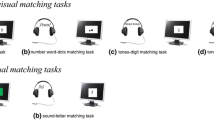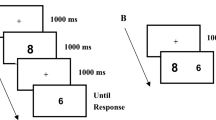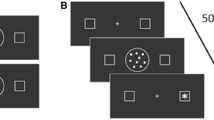Abstract
In number–space synesthesia, numbers are visualized in spatially defined arrays. In a recent study (Gertner et al. in Cortex, doi:10.1016/j.cortex.2012.03.019, 2012), we found that the size congruency effect (SiCE) for physical judgments (i.e., comparing numbers’ physical sizes while ignoring their numerical values, for example,  8) was modulated by the spatial position of the presented numbers. Surprisingly, we found that the neutral condition, which is comprise solely of physical sizes (e.g.,
8) was modulated by the spatial position of the presented numbers. Surprisingly, we found that the neutral condition, which is comprise solely of physical sizes (e.g.,  3), was affected as well. This pattern gave rise to the idea that number–space synesthesia might entail not only discrete, ordered, meaningful symbols (i.e., Arabic numbers) but also continuous non-symbolic magnitudes (i.e., sizes, length, luminance, etc.). We tested this idea by assessing the performance of two number–space synesthetes and 12 matched controls in 3 comparative judgment tasks involving symbolic and non-symbolic stimuli: (1) Arabic numbers, (2) dot clusters, and (3) sizes of squares. The spatial position of the presented stimuli was manipulated to be compatible or incompatible with respect to the synesthetic number–space perceptions. Results revealed that for synesthetes, but not for controls, non-symbolic magnitudes (dot clusters) as well as symbolic magnitudes (i.e., Arabic numbers) interacted with space. Our study suggests that number–space synesthetes might have a general magnitude–space association that is not restricted to concrete symbolic stimuli. These findings support recent theories on the perception and evaluation of sizes in numerical cognition.
3), was affected as well. This pattern gave rise to the idea that number–space synesthesia might entail not only discrete, ordered, meaningful symbols (i.e., Arabic numbers) but also continuous non-symbolic magnitudes (i.e., sizes, length, luminance, etc.). We tested this idea by assessing the performance of two number–space synesthetes and 12 matched controls in 3 comparative judgment tasks involving symbolic and non-symbolic stimuli: (1) Arabic numbers, (2) dot clusters, and (3) sizes of squares. The spatial position of the presented stimuli was manipulated to be compatible or incompatible with respect to the synesthetic number–space perceptions. Results revealed that for synesthetes, but not for controls, non-symbolic magnitudes (dot clusters) as well as symbolic magnitudes (i.e., Arabic numbers) interacted with space. Our study suggests that number–space synesthetes might have a general magnitude–space association that is not restricted to concrete symbolic stimuli. These findings support recent theories on the perception and evaluation of sizes in numerical cognition.


Similar content being viewed by others
References
Cantlon JF, Platt ML, Brannon EM (2009) Beyond the number domain. Trends Cogn Sci 13:83–91
Cohen Kadosh R, Gertner L (2011) Synesthesia: gluing together time, number and space. In: Dehaene S, Brannon E (eds) Space, time and number in the brain: Searching for the foundations of mathematical thought. Elsevier/Academic Press, Burlington, pp 123–132
Dehaene S, Bossini S, Giraux P (1993) The mental representation of parity and number magnitude. J Exp Psychol General 122:371–396
Gertner L, Cohen Kadosh R, Henik A (2009) When 9 is not on the right: Implications from number-form synesthesia. Conscious Cogn 18:366–374
Gertner L, Henik A, Reznik D, Cohen Kadosh R (2012) Implications of number-space synesthesia on the automaticity of numerical processing. Cortex. doi:10.1016/j.cortex.2012.03.019
Henik A, Tzelgov J (1982) Is three greater than five: the relation between physical and semantic size in comparison tasks. Memory Cogn 10:389–395
Henik A, Leibovich T, Naparstek S, Diesendruck L, Rubinsten O (2012) Quantities, amounts, and the numerical core system. Frontiers Human Neurosci 5:186
Jarick M, Dixon MJ, Maxwell EC, Nicholls MER, Smilek D (2009) The ups and downs (and lefts and rights) of synesthetic number forms: validation from spatial cueing and SNARC-type tasks. Cortex 45:1190–1199
Murray SO, Boyaci H, Kersten D (2006) The representation of perceived angular size in human primary visual cortex. Nat Neurosci 9:429–434
Piazza M, Pinel P, Dehaene S (2006) Objective correlates of an unusual subjective experience: a single case study of number-form synesthesia. Cogn Neuropsychol 23:1162–1173
Price MC (2009) Spatial forms and mental imagery. Cortex 45:1229–1245
Sagiv N, Simner J, Collins J, Butterworth B, Ward J (2006) What is the relationship between synaesthesia and visuo-spatial number form? Cognition 101:114–128
Tzelgov J (1997) Specifying the relations between automaticity and consciousness: a theoretical note. Conscious Cogn 6:441–451
Conflict of interest
This supplement was not sponsored by outside commercial interests. It was funded entirely by ECONA, Via dei Marsi, 78, 00185 Roma, Italy
Author information
Authors and Affiliations
Corresponding author
Rights and permissions
About this article
Cite this article
Gertner, L., Arend, I. & Henik, A. Effects of non-symbolic numerical information suggest the existence of magnitude–space synesthesia. Cogn Process 13 (Suppl 1), 179–183 (2012). https://doi.org/10.1007/s10339-012-0449-9
Published:
Issue Date:
DOI: https://doi.org/10.1007/s10339-012-0449-9




